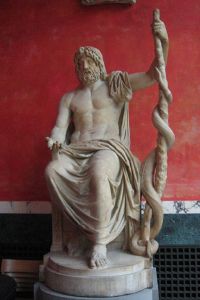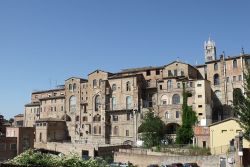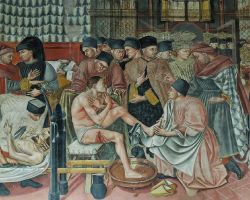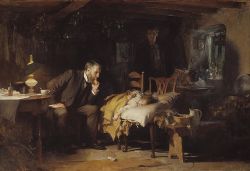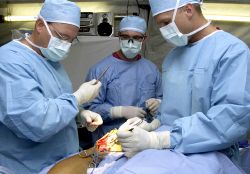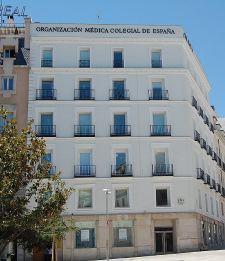Medicine
Medicine is the science and practice of establishing the diagnosis, prognosis, treatment, and prevention of disease. It encompasses a variety of health care practices developed to maintain and restore health. Medicine is both the science and art of healing. The development of modern medicine in many cases provides effective treatment of disease and healing from injury, which is a great benefit to humankind.
Contemporary medicine applies biomedical sciences, biomedical research, genetics, and medical technology to diagnose, treat, and prevent injury and disease, typically through pharmaceuticals or surgery, but also through therapies as diverse as psychotherapy, external splints and traction, medical devices, biologics, and ionizing radiation.
Etymology
Medicine is the science and practice of the diagnosis, prognosis, treatment, and prevention of disease. The word "medicine" is derived from Latin ars medicina "the medical art," from medicus meaning "a physician."[1]
History
Medicine has been around for thousands of years, during most of which it was an art (an area of skill and knowledge) frequently having connections to the religious and philosophical beliefs of local culture. For example, a medicine man would apply herbs and say prayers for healing, or an ancient philosopher and physician would apply bloodletting according to the theories of humorism. In recent centuries, since the advent of modern science, most medicine has become a combination of art and science (both basic and applied, under the umbrella term "medical science." Thus, while the stitching technique for sutures is an art learned through practice, the knowledge of what happens at the cellular and molecular level in the tissues being stitched arises through science.
Ancient world
Prehistoric medicine incorporated plants (herbalism), animal parts, and minerals. In many cases these materials were used ritually as magical substances by priests, shamans, or medicine men. Well-known spiritual systems include animism (the notion of inanimate objects having spirits), spiritualism (an appeal to gods or communion with ancestor spirits); shamanism (the vesting of an individual with mystic powers); and divination (magically obtaining the truth).
Early records on medicine have been discovered from ancient Egyptian medicine, Babylonian Medicine, Ayurvedic medicine (in the Indian subcontinent), classical Chinese medicine (predecessor to the modern traditional Chinese medicine), and ancient Greek medicine and Roman medicine.
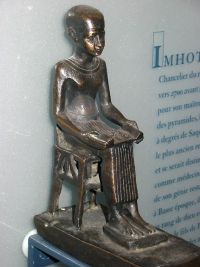
In Egypt, Imhotep (third millennium B.C.E.) is the first physician in history known by name. The oldest Egyptian medical text is the Kahun Gynaecological Papyrus from around 2000 B.C.E., which describes gynecological diseases. The Edwin Smith Papyrus dating back to 1600 B.C.E. is an early work on surgery, while the Ebers Papyrus dating back to 1500 B.C.E. is akin to a textbook on medicine.[2]
In China, archaeological evidence of medicine dates back to the Bronze Age Shang Dynasty, based on seeds for herbalism and tools presumed to have been used for surgery.[3] The Huangdi Neijing, the progenitor of Chinese medicine, is a medical text written beginning in the second century B.C.E. .and compiled in the third century.[4]
In India, the surgeon Sushruta described numerous surgical operations, including the earliest forms of plastic surgery.[5] The earliest records of dedicated hospitals come from Mihintale in Sri Lanka where evidence of dedicated medicinal treatment facilities for patients are found.[6]
In Greece, the Greek physician Hippocrates, the "father of modern medicine," laid the foundation for a rational approach to medicine. Hippocrates introduced the Hippocratic Oath for physicians, which is still relevant and in use today, and was the first to categorize illnesses as acute, chronic, endemic and epidemic, and use terms such as exacerbation, relapse, resolution, crisis, paroxysm, peak, and convalescence.[7] The Greek physician Galen, who became a physician in the Roman Empire, was one of the greatest surgeons of the ancient world. He performed many audacious operations, including brain and eye surgeries. After the fall of the Western Roman Empire and the onset of the Early Middle Ages, the Greek tradition of medicine went into decline in Western Europe, although it continued uninterrupted in the Eastern Roman (Byzantine) Empire.
Most of our knowledge of ancient Hebrew medicine during the first millennium B.C.E. comes from the Torah (the Five Books of Moses), which contain various health related laws and rituals.
Middle Ages
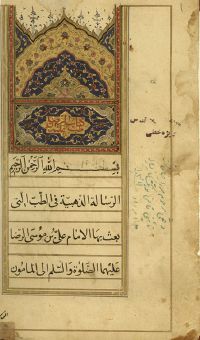
Although the concept of uroscopy, the practice of visually examining a patient's urine for pus, blood, or other symptoms of disease, was known to Galen, he did not see the importance of using it to localize disease. It was under the Byzantines with physicians such of Theophilus Protospatharius that they realized the potential of uroscopy to determine disease in a time when no microscope or stethoscope existed. That practice eventually spread to the rest of Europe.[8] The Jewish contribution to the development of modern medicine started in the Byzantine Era, with the physician Asaph the Jew.[9]
The concept of hospital as institution to offer medical care and possibility of a cure for the patients due to the ideals of Christian charity, rather than just merely a place to die, also appeared in the Byzantine Empire.[10]
In the Muslim world, the Persian Bimaristan hospitals were an early example of public hospitals.[11] After 750 C.E., the works of Hippocrates, Galen, and Sushruta were translated into Arabic, and Islamic physicians engaged in some significant medical research. Notable Islamic medical pioneers include the Persian polymath, Avicenna, who wrote The Canon of Medicine which became a standard medical text at many medieval European universities and is considered one of the most famous books in the history of medicine. Others include Abulcasis, Avenzoar, Ibn al-Nafis, and Averroes. Persian physician Rhazes was one of the first to question the Greek theory of humorism, which nevertheless remained influential in both medieval Western and medieval Islamic medicine.[12] Some volumes of Rhazes' work Al-Mansuri, namely "On Surgery" and "A General Book on Therapy," became part of the medical curriculum in European universities. He is known as the father of pediatrics, and a pioneer of ophthalmology, being the first to recognize the reaction of the eye's pupil to light.[13] Al-Risalah al-Dhahabiah by Ali al-Ridha, the eighth Imam of Shia Muslims, is revered as the most precious Islamic literature in the Science of Medicine.[14]
In Europe, Charlemagne decreed that a hospital should be attached to each cathedral and monastery: "It conducted hospitals for the old and orphanages for the young; hospices for the sick of all ages; places for the lepers; and hostels or inns where pilgrims could buy a cheap bed and meal."[15] The Benedictine order was noted for setting up hospitals and infirmaries in their monasteries, growing medical herbs, and becoming the chief medical care givers of their districts, as at the great Abbey of Cluny. The Church also established a network of cathedral schools and universities where medicine was studied. The Schola Medica Salernitana in Salerno, looking to the learning of Greek and Arab physicians, grew to be the finest medical school in Medieval Europe.
However, the fourteenth and fifteenth century Black Death devastated both the Middle East and Europe. During this time there was a gradual shift from the traditional approach to science and medicine. Physicians like Andreas Vesalius improved upon, or disproved, some of the theories from the past. Vesalius was the author of De humani corporis fabrica ("On the Workings of the Human Body"), an important book on human anatomy. Bacteria and microorganisms were first observed with a microscope by Antonie van Leeuwenhoek in 1676, initiating the scientific field microbiology.[16] The seventeenth‚Äďcentury French physician, Pierre Fauchard, started dentistry science as we know it today, earning the title "the father of modern dentistry." His book, The Surgeon Dentist: A Treatise on Teeth, was the first to describe a comprehensive system for dentistry practice.
In the early modern period, important early figures in medicine and anatomy emerged in Europe, including Gabriele Falloppio and William Harvey.
Modern
in 1761, the French veterinarian Claude Bourgelat founded the world's first veterinary school in Lyon, France, establishing for the first time veterinary medicine separate from human medicine. Before this, medical doctors treated both humans and animals.
The modern era really began with Edward Jenner's discovery of the smallpox vaccine at the end of the eighteenth century (inspired by the method of inoculation earlier practiced in Asia), Robert Koch's discoveries around 1880 of the transmission of disease by bacteria, and then the discovery of antibiotics around 1900.
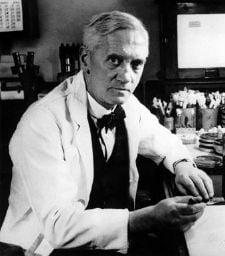
The post-eighteenth century modernity period brought more groundbreaking researchers from Europe. From Germany and Austria, doctors Rudolf Virchow, Wilhelm Conrad Röntgen, Karl Landsteiner, and Otto Loewi made notable contributions. In the United Kingdom, Alexander Fleming, Joseph Lister, Francis Crick, and Florence Nightingale are considered important. Spanish doctor Santiago Ramón y Cajal is considered the father of modern neuroscience.
From New Zealand and Australia came Maurice Wilkins, Howard Florey, and Frank Macfarlane Burnet.
Others that did significant work include William Williams Keen, William Coley, James D. Watson (United States); Salvador Luria (Italy); Alexandre Yersin (Switzerland); Kitasato ShibasaburŇć (Japan); Jean-Martin Charcot, Claude Bernard, Paul Broca (France); Adolfo Lutz (Brazil); Nikolai Korotkov (Russia); Sir William Osler (Canada); and Harvey Cushing (United States).
As science and technology developed, medicine became more reliant upon medications. Throughout history and in Europe right until the late eighteenth century, not only animal and plant products were used as medicine, but also human body parts and fluids. Pharmacology developed in part from herbalism and some drugs are still derived from plants, such as atropine, ephedrine, warfarin, aspirin, digoxin, and others. Vaccines were discovered by Edward Jenner and Louis Pasteur and the first vaccine was used to prevent rabies in 1885.
The first antibiotic was arsphenamine (Salvarsan) discovered by Paul Ehrlich in 1908 after he observed that bacteria took up toxic dyes that human cells did not. The first major class of antibiotics was the sulfa drugs, derived by German chemists originally from azo dyes.
Pharmacology has become increasingly sophisticated; modern biotechnology allows drugs targeted towards specific physiological processes to be developed. Genomics and knowledge of human genetics and human evolution is having increasingly significant influence on medicine, as the causative genes of most monogenic genetic disorders have now been identified, and the development of techniques in molecular biology, evolution, and genetics are influencing medical technology, practice, and decision-making.
Evidence-based medicine is a contemporary movement to establish the most effective algorithms of medical practice through the use of systematic reviews and meta-analysis. The movement is facilitated by modern global information science, which allows as much of the available evidence as possible to be collected and analyzed according to standard protocols that are then disseminated to health care providers.
Traditional medicine
Prescientific forms of medicine are now known as traditional medicine and folk medicine, though they do not fall within the modern definition of ‚Äúmedicine‚ÄĚ which is based in medical science. Traditional medicine and folk medicine remain commonly used with, or instead of, scientific medicine and are thus called alternative medicine (meaning ‚Äú[something] other than medicine,‚ÄĚ from Latin alter, ‚Äúother‚ÄĚ).
The World Health Organization (WHO) defines traditional medicine as "the sum total of the knowledge, skills, and practices based on the theories, beliefs, and experiences indigenous to different cultures, whether explicable or not, used in the maintenance of health as well as in the prevention, diagnosis, improvement or treatment of physical and mental illness."[17] Practices known as traditional medicines include Ayurveda, Siddha medicine, Unani, ancient Iranian medicine, Irani, Islamic medicine, traditional Chinese medicine, traditional Korean medicine, acupuncture, Muti, If√°, and traditional African medicine.
Institutions
Contemporary medicine is usually conducted within health care systems. Legal, credentialing, and financing frameworks are established by individual governments, augmented on occasion by international organizations, such as churches. For example, the Christian emphasis on practical charity gave rise to the development of systematic nursing and hospitals, and the Catholic Church today remains the largest non-government provider of medical services in the world.[15] The characteristics of any given health care system have significant impact on the way medical care is provided.
Nations design and develop health systems in accordance with their needs and resources, although common elements in virtually all health systems are primary healthcare and public health measures. In some countries, health system planning is distributed among market participants. In others, there is a concerted effort among governments, trade unions, charities, religious organizations, or other bodies to deliver planned health care services targeted to the populations they serve.
Delivery
- See also: Health care , clinic , hospital , and hospice
Provision of medical care is classified into primary, secondary, tertiary, and sometimes quaternary care categories.
Primary care medical services are provided by physicians, physician assistants, nurse practitioners, or other health professionals who have first contact with a patient seeking medical treatment or care. These occur in physician offices, clinics, nursing homes, schools, home visits, and other places close to patients. The majority of medical visits can be treated by the primary care provider, including treatment of acute and chronic illnesses, preventive care, and health education for all ages and both sexes.
Secondary care medical services are provided by medical specialists for patients referred by their primary care provider, who require the expertise or procedures performed by specialists. These include both ambulatory care and inpatient services, Emergency departments, intensive care medicine, surgery services, physical therapy, labor and delivery, endoscopy units, diagnostic laboratory, and medical imaging services, hospice centers, and others.
Tertiary care medical services are provided by specialist hospitals or regional centers equipped with diagnostic and treatment facilities not generally available at local hospitals. These include trauma centers, burn treatment centers, advanced neonatology unit services, organ transplants, high-risk pregnancy, radiation oncology, among others.
The term quaternary care may be used as an extension of tertiary care in reference to advanced levels of medicine which are highly specialized and not widely accessed.
Separation of prescribing and dispensing is a practice in medicine and pharmacy in which the physician who provides a medical prescription is independent from the pharmacist who provides the prescription drug. In the Western world there are centuries of tradition for separating pharmacists from physicians. In Asian countries, on the other hand, it is traditional for physicians to also provide drugs.
Clinical practice
Medical availability and clinical practice varies across the world due to regional differences in culture and technology. Modern scientific medicine is highly developed in the Western world, while in developing countries such as parts of Africa or Asia, the population may rely more heavily on traditional medicine. Modern medical care depends on information ‚Äď still delivered in many health care settings on paper records, but increasingly nowadays by electronic means.
In modern clinical practice, physicians personally assess patients in order to diagnose, prognose, treat, and prevent disease using clinical judgment. The doctor-patient relationship typically begins an interaction with an examination of the patient's medical history and medical record, followed by a medical interview[18] and a physical examination. Basic diagnostic medical devices (such as a stethoscope and tongue depressor) are typically used. After examination for signs and interviewing for symptoms, the doctor may order medical tests (such as blood tests), take a biopsy, or prescribe pharmaceutical drugs or other therapies. Differential diagnosis methods help to rule out conditions based on the information provided. During the encounter, properly informing the patient of all relevant facts is an important part of the relationship and the development of trust. The medical encounter is then documented in the medical record. Follow-up visits may be shorter but follow the same general procedure, and specialists follow a similar process. The diagnosis and treatment may take only a few minutes or a few weeks depending upon the complexity of the issue.
The components of the medical interview[18] and encounter are:
- Chief complaint (CC): the reason for the current medical visit. These are the 'symptoms.' They are in the patient's own words and are recorded along with the duration of each one. Also called 'chief concern' or 'presenting complaint.'
- History of present illness (HPI): the chronological order of events of symptoms and further clarification of each symptom. Distinguishable from history of previous illness, often called past medical history (PMH). Medical history comprises HPI and PMH.
- Current activity: occupation, hobbies, the patient's general lifestyle.
- Medications (Rx): what drugs the patient takes including prescribed, over-the-counter, and home remedies, as well as alternative and herbal medicines/herbal remedies. Allergies are also recorded.
- Past medical history (PMH/PMHx): concurrent medical problems, past hospitalizations and operations, injuries, past infectious diseases or vaccinations, history of known allergies.
- Social history (SH): birthplace, residences, marital history, social and economic status, habits (including diet, medications, tobacco, alcohol).
- Family history (FH): listing of diseases in the family that may impact the patient. A family tree is sometimes used.
- Review of systems (ROS) or systems inquiry: a set of additional questions to ask, which may be missed on HPI: a general enquiry (have you noticed any weight loss, change in sleep quality, fevers, lumps, and so forth, followed by questions on the body's main organ systems (heart, lungs, digestive tract, urinary tract, and so on).
The physical examination is the examination of the patient for medical signs of disease, which are objective and observable, in contrast to symptoms which are volunteered by the patient and not necessarily objectively observable.[19] Four actions are the basis of physical examination: inspection, palpation (feel), percussion (tap to determine resonance characteristics), and auscultation (listen).
The clinical examination involves the study of:
- Vital signs including height, weight, body temperature, blood pressure, pulse, respiration rate, and hemoglobin oxygen saturation
- General appearance of the patient and specific indicators of disease (nutritional status, presence of jaundice, pallor or clubbing)
- Skin
- Head, eye, ear, nose, and throat (HEENT)
- Cardiovascular (heart and blood vessels)
- Respiratory (large airways and lungs)
- Abdomen and rectum
- Genitalia (and pregnancy if the patient is or could be pregnant)
- Musculoskeletal (including spine and extremities)
- Neurological (consciousness, awareness, brain, vision, cranial nerves, spinal cord, and peripheral nerves)
- Psychiatric (orientation, mental state, mood, evidence of abnormal perception or thought).
The medical decision-making (MDM) process involves analysis and synthesis of all the above data to come up with a list of possible diagnoses (the differential diagnoses), along with an idea of what needs to be done to obtain a definitive diagnosis that would explain the patient's problem.
The treatment plan may include ordering additional medical laboratory tests and medical imaging studies, starting therapy, referral to a specialist, or watchful observation. On subsequent visits, the process may be repeated in an abbreviated manner to obtain any new history, symptoms, physical findings, and lab or imaging results or specialist consultations.
Branches of medicine
Working together as an interdisciplinary team, many highly trained health professionals are involved in the delivery of modern health care. Examples include: nurses, emergency medical technicians and paramedics, laboratory scientists, pharmacists, podiatrists, physiotherapists, respiratory therapists, speech therapists, occupational therapists, radiographers, dietitians, and bioengineers, medical physics, surgeons, surgeon's assistant, surgical technologist.
The scope and sciences underpinning human medicine overlap many other fields. Dentistry, while considered by some a separate discipline from medicine, is a medical field.
Physicians have many specializations and subspecializations into certain branches of medicine. There are variations from country to country regarding which specialties certain subspecialties are in.
The main branches of medicine are:
- Basic sciences of medicine; this is what every physician is educated in, and some return to in biomedical research
- Medical specialties
- Interdisciplinary fields, where different medical specialties are mixed to function in certain occasions.
Basic sciences
- Anatomy is the study of the physical structure of organisms. In contrast to macroscopic or gross anatomy, cytology and histology are concerned with microscopic structures.
- Biochemistry is the study of the chemistry taking place in living organisms, especially the structure and function of their chemical components.
- Biomechanics is the study of the structure and function of biological systems by means of the methods of Mechanics.
- Biostatistics is the application of statistics to biological fields in the broadest sense. A knowledge of biostatistics is essential in the planning, evaluation, and interpretation of medical research. It is also fundamental to epidemiology and evidence-based medicine.
- Biophysics is an interdisciplinary science that uses the methods of physics and physical chemistry to study biological systems.
- Cytology is the microscopic study of individual cells.
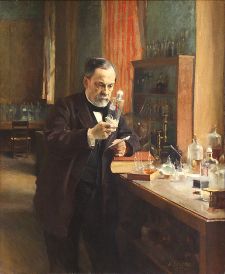
- Embryology is the study of the early development of organisms.
- Endocrinology is the study of hormones and their effect throughout the body of animals.
- Epidemiology is the study of the demographics of disease processes, and includes, but is not limited to, the study of epidemics.
- Genetics is the study of genes, and their role in biological inheritance.
- Histology is the study of the structures of biological tissues by light microscopy, electron microscopy and immunohistochemistry.
- Immunology is the study of the immune system, which includes the innate and adaptive immune system in humans, for example.
- Medical physics is the study of the applications of physics principles in medicine.
- Microbiology is the study of microorganisms, including protozoa, bacteria, fungi, and viruses.
- Molecular biology is the study of molecular underpinnings of the process of replication, transcription and translation of the genetic material.
- Neuroscience includes those disciplines of science that are related to the study of the nervous system. A main focus of neuroscience is the biology and physiology of the human brain and spinal cord. Some related clinical specialties include neurology, neurosurgery and psychiatry.
- Nutrition science (theoretical focus) and dietetics (practical focus) is the study of the relationship of food and drink to health and disease, especially in determining an optimal diet. Medical nutrition therapy is done by dietitians and is prescribed for diabetes, cardiovascular diseases, weight and eating disorders, allergies, malnutrition, and neoplastic diseases.
- Pathology as a science is the study of disease‚ÄĒthe causes, course, progression and resolution thereof.
- Pharmacology is the study of drugs and their actions.
- Photobiology is the study of the interactions between non-ionizing radiation and living organisms.
- Physiology is the study of the normal functioning of the body and the underlying regulatory mechanisms.
- Radiobiology is the study of the interactions between ionizing radiation and living organisms.
- Toxicology is the study of hazardous effects of drugs and poisons.
Specialties
Within medical circles, specialities usually fit into one of two broad categories: "Medicine" and "Surgery." "Medicine" refers to the practice of non-operative medicine, and most of its subspecialties require preliminary training in Internal Medicine. "Surgery" refers to the practice of operative medicine, and most subspecialties in this area require preliminary training in General Surgery.
Some specialties of medicine do not fit easily into either of these categories, such as radiology, pathology, or anesthesia. Most of these have branched from one or other of the two camps above.
Surgical specialty
Surgery is an ancient medical specialty that uses operative manual and instrumental techniques on a patient to investigate or treat a pathological condition such as disease or injury, to help improve bodily function or appearance or to repair unwanted ruptured areas (for example, a perforated ear drum). Surgeons must also manage pre-operative, post-operative, and potential surgical candidates on the hospital wards.
Surgery has many sub-specialties, including general surgery, ophthalmic surgery, cardiovascular surgery, colorectal surgery, neurosurgery, oral and maxillofacial surgery, oncologic surgery, orthopedic surgery, otolaryngology, plastic surgery, podiatric surgery, transplant surgery, trauma surgery, urology, vascular surgery, and pediatric surgery. In some centers, anesthesiology is part of the division of surgery (for historical and logistical reasons), although it is not a surgical discipline. Other medical specialties may employ surgical procedures, such as ophthalmology and dermatology, but are not considered surgical sub-specialties per se.
Internal specialty
Internal medicine is the medical specialty dealing with the prevention, diagnosis, and treatment of adult diseases.
Because their patients are often seriously ill or require complex investigations, those practicing internal medicine do much of their work in hospitals. Formerly, they were not subspecialized; such general physicians would see any complex nonsurgical problem. However, this style of practice has become much less common. In modern urban practice, most are subspecialists: that is, they generally limit their medical practice to problems of one organ system or to one particular area of medical knowledge. For example, gastroenterologists and nephrologists specialize respectively in diseases of the gut and the kidneys.
In the some countries, specialist pediatricians and geriatricians are also described as specialist physicians who have subspecialized by age of patient rather than by organ system. Elsewhere, especially in North America, general pediatrics is often a form of primary care.
There are many subspecialities (or subdisciplines) of internal medicine:
- Angiology/Vascular Medicine
- Cardiology
- Critical care medicine
- Endocrinology
- Gastroenterology
- Geriatrics
- Hematology
- Hepatology
- Infectious disease
- Nephrology
- Neurology
- Oncology
- Pediatrics
- Pulmonology/Pneumology/Respirology/chest medicine
- Rheumatology
- Sports Medicine
Diagnostic specialties
- Clinical laboratory sciences are the clinical diagnostic services that apply laboratory techniques to diagnosis and management of patients. The personnel that work in these medical laboratory departments are technically trained staff who do not hold medical degrees, but who usually hold an undergraduate medical technology degree, who actually perform the tests, assays, and procedures needed for providing the specific services. Subspecialties include transfusion medicine, cellular pathology, clinical chemistry, hematology, clinical microbiology and clinical immunology.
- Pathology as a medical specialty is the branch of medicine that deals with the study of diseases and the morphologic, physiologic changes produced by them. As a diagnostic specialty, pathology can be considered the basis of modern scientific medical knowledge and plays a large role in evidence-based medicine. Many modern molecular tests such as flow cytometry, polymerase chain reaction (PCR), immunohistochemistry, cytogenetics, gene rearrangements studies and fluorescent in situ hybridization (FISH) fall within the territory of pathology.
- Diagnostic radiology is concerned with imaging of the body, such as by x-rays, x-ray computed tomography, ultrasonography, and nuclear magnetic resonance tomography. Interventional radiologists can access areas in the body under imaging for an intervention or diagnostic sampling.
- Nuclear medicine is concerned with studying human organ systems by administering radiolabelled substances (radiopharmaceuticals) to the body, which can then be imaged outside the body by a gamma camera or a PET scanner. Each radiopharmaceutical consists of two parts: a tracer that is specific for the function under study (for example, neurotransmitter pathway, metabolic pathway, blood flow, or other), and a radionuclide (usually either a gamma-emitter or a positron emitter). There is a degree of overlap between nuclear medicine and radiology, as evidenced by the emergence of combined devices such as the PET/CT scanner.
- Clinical neurophysiology is concerned with testing the physiology or function of the central and peripheral aspects of the nervous system. These kinds of tests can be divided into recordings of: (1) spontaneous or continuously running electrical activity, or (2) stimulus evoked responses. Subspecialties include electroencephalography, electromyography, evoked potential, nerve conduction study and polysomnography. Sometimes these tests are performed by technicians without a medical degree, but the interpretation of these tests is done by a medical professional.
Other major specialties
The following are some major medical specialties that do not directly fit into any of the above-mentioned groups:
- Anesthesiology (also known as anaesthetics): concerned with the perioperative management of the surgical patient. The anesthesiologist's role during surgery is to prevent derangement in the function of the vital organs (brain, heart, kidneys) and postoperative pain. Outside of the operating room, the anesthesiology physician also serves the same function in the labor and delivery ward, and some are specialized in critical medicine.
- Dermatology is concerned with the skin and its diseases.
- Emergency medicine is concerned with the diagnosis and treatment of acute or life-threatening conditions, including trauma, surgical, medical, pediatric, and psychiatric emergencies.
- Family medicine, family practice, general practice, or primary care is, in many countries, the first port-of-call for patients with non-emergency medical problems. Family physicians often provide services across a broad range of settings including office based practices, emergency department coverage, inpatient care, and nursing home care.
- Obstetrics and gynecology (often abbreviated as OB/GYN (American English) or Obs & Gynae (British English)) are concerned respectively with childbirth and the female reproductive and associated organs. Reproductive medicine and fertility medicine are generally practiced by gynecological specialists.
- Medical genetics is concerned with the diagnosis and management of hereditary disorders.
- Neurology is concerned with diseases of the nervous system.
- Ophthalmology is exclusively concerned with the eye and ocular adnexa, combining conservative and surgical therapy.
- Pediatrics (AE) or paediatrics (BE) is devoted to the care of infants, children, and adolescents. Like internal medicine, there are many pediatric subspecialties for specific age ranges, organ systems, disease classes, and sites of care delivery.
- Pharmaceutical medicine is the medical scientific discipline concerned with the discovery, development, evaluation, registration, monitoring and medical aspects of marketing of medicines for the benefit of patients and public health.
- Physical medicine and rehabilitation (or physiatry) is concerned with functional improvement after injury, illness, or congenital disorders.
- Podiatric medicine is the study of, diagnosis, and medical & surgical treatment of disorders of the foot, ankle, lower limb, hip and lower back.
- Psychiatry is the branch of medicine concerned with the bio-psycho-social study of the etiology, diagnosis, treatment and prevention of cognitive, perceptual, emotional and behavioral disorders. Related non-medical fields include psychotherapy and clinical psychology.
- Preventive medicine is the branch of medicine concerned with preventing disease.
- Community health or public health is an aspect of health services concerned with threats to the overall health of a community based on population health analysis.
Interdisciplinary fields
Some interdisciplinary sub-specialties of medicine include:
- Aerospace medicine deals with medical problems related to flying and space travel.
- Addiction medicine deals with the treatment of addiction.
- Medical ethics deals with ethical and moral principles that apply values and judgments to the practice of medicine.
- Biomedical Engineering is a field dealing with the application of engineering principles to medical practice.
- Clinical pharmacology is concerned with how systems of therapeutics interact with patients.
- Conservation medicine studies the relationship between human and animal health, and environmental conditions. Also known as ecological medicine, environmental medicine, or medical geology.
- Disaster medicine deals with medical aspects of emergency preparedness, disaster mitigation and management.
- Diving medicine (or hyperbaric medicine) is the prevention and treatment of diving-related problems.
- Evolutionary medicine is a perspective on medicine derived through applying evolutionary theory.
- Forensic medicine deals with medical questions in legal context, such as determination of the time and cause of death, type of weapon used to inflict trauma, reconstruction of the facial features using remains of deceased (skull) thus aiding identification.
- Gender-based medicine studies the biological and physiological differences between the human sexes and how that affects differences in disease.
- Hospice and Palliative Medicine is a relatively modern branch of clinical medicine that deals with pain and symptom relief and emotional support in patients with terminal illnesses including cancer and heart failure.
- Hospital medicine is the general medical care of hospitalized patients.
- Laser medicine involves the use of lasers in the diagnostics or treatment of various conditions.
- Medical humanities includes the humanities (literature, philosophy, ethics, history and religion), social science (anthropology, cultural studies, psychology, sociology), and the arts (literature, theater, film, and visual arts) and their application to medical education and practice.
- Health informatics is a relatively recent field that deals with the application of computers and information technology to medicine.
- Nosology is the classification of diseases for various purposes.
- Nosokinetics is the science/subject of measuring and modelling the process of care in health and social care systems.
- Occupational medicine is the provision of health advice to organizations and individuals to ensure that the highest standards of health and safety at work can be achieved and maintained.
- Pain management (also called pain medicine, or algiatry) is the medical discipline concerned with the relief of pain.
- Pharmacogenomics is a form of individualized medicine.
- Podiatric medicine is the study of, diagnosis, and medical treatment of disorders of the foot, ankle, lower limb, hip, and lower back.
- Sexual medicine is concerned with diagnosing, assessing, and treating all disorders related to sexuality.
- Sports medicine deals with the treatment and prevention and rehabilitation of sports/exercise injuries such as muscle spasms, muscle tears, injuries to ligaments (ligament tears or ruptures) and their repair in athletes, amateur and professional.
- Therapeutics is the field, more commonly referenced in earlier periods of history, of the various remedies that can be used to treat disease and promote health.
- Travel medicine or emporiatrics deals with health problems of international travelers or travelers across highly different environments.
- Tropical medicine deals with the prevention and treatment of tropical diseases. It is studied separately in temperate climates where those diseases are quite unfamiliar to medical practitioners and their local clinical needs.
- Urgent care focuses on delivery of unscheduled, walk-in care outside of the hospital emergency department for injuries and illnesses that are not severe enough to require care in an emergency department. In some jurisdictions this function is combined with the emergency department.
- Veterinary medicine; veterinarians apply similar techniques as physicians to the care of animals.
- Wilderness medicine entails the practice of medicine in the wild, where conventional medical facilities may not be available.
- Many other health science fields, such as dietetics.
Education and legal controls
Medical education and training varies around the world. It typically involves entry level education at a university medical school, followed by a period of supervised practice or internship, or residency. This can be followed by postgraduate vocational training. In Canada and the United States of America, a Doctor of Medicine degree, often abbreviated M.D., or a Doctor of Osteopathic Medicine degree, often abbreviated as D.O. and unique to the United States, must be completed in and delivered from a recognized university.
Since knowledge, techniques, and medical technology continue to evolve at a rapid rate, many regulatory authorities require continuing medical education. Medical practitioners upgrade their knowledge in various ways, including medical journals, seminars, conferences, and online programs.
In most countries, it is a legal requirement for a medical doctor to be licensed or registered. In general, this entails a medical degree from a university and accreditation by a medical board or an equivalent national organization, which may ask the applicant to pass exams. This restricts the considerable legal authority of the medical profession to physicians that are trained and qualified by national standards. It is also intended as an assurance to patients of treatment by qualified practitioners. While the laws generally require medical doctors to be trained in "evidence based," Western, or Hippocratic Medicine, they are not intended to discourage different paradigms of health.
Doctors who are negligent or intentionally harmful in their care of patients can face charges of medical malpractice and be subject to civil, criminal, or professional sanctions.
Medical ethics
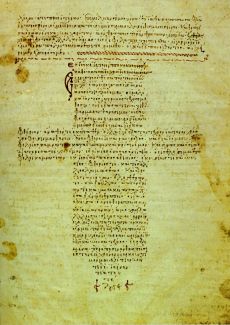
Medical ethics is a system of moral principles that apply values and judgments to the practice of medicine. As a scholarly discipline, medical ethics encompasses its practical application in clinical settings as well as work on its history, philosophy, theology, and sociology. Six of the values that commonly apply to medical ethics discussions are:
- autonomy ‚Äď the patient has the right to refuse or choose their treatment. (Voluntas aegroti suprema lex.)
- beneficence ‚Äď a practitioner should act in the best interest of the patient. (Salus aegroti suprema lex.)
- justice ‚Äď concerns the distribution of scarce health resources, and the decision of who gets what treatment (fairness and equality).
- non-maleficence ‚Äď "first, do no harm" (primum non-nocere).
- respect for persons ‚Äď the patient (and the person treating the patient) have the right to be treated with dignity.
- truthfulness and honesty ‚Äď the concept of informed consent has increased in importance since the historical events of the Doctors' Trial of the Nuremberg trials, Tuskegee syphilis experiment, and others.
Values such as these do not give answers as to how to handle a particular situation, but provide a useful framework for understanding conflicts. When moral values are in conflict, the result may be an ethical dilemma or crisis. Sometimes, no good solution to a dilemma in medical ethics exists, and occasionally, the values of the medical community (namely, the hospital and its staff) conflict with the values of the individual patient, family, or larger non-medical community. Conflicts may also arise between health care providers, or among family members.
Notes
- ‚ÜĎ Medicine Online Etymology Dictionary. Retrieved April 10, 2020.
- ‚ÜĎ Erwin Heinz Ackerknecht, A Short History of Medicine (Literary Licensing, 2012, ISBN 978-1258427368).
- ‚ÜĎ Francis Hong, History of Medicine in China: When Medicine Took an Alternative Path McGill Journal of Medicine 8(1) (2004): 79-84. Retrieved April 10, 2020.
- ‚ÜĎ Paul U. Unschuld Huang Di Nei Jing: Nature, Knowledge, Imagery in an Ancient Chinese Medical Text (University of California Press, 2003, ISBN 978-0520233225).
- ‚ÜĎ Satish Saroshe, Sushruta: the ancient Indian surgeon Hektoen International Journal 8(1) (Winter 2016). Retrieved April 10, 2020.
- ‚ÜĎ W.I. Siriweera, Hospitals in ancient Sri Lanka Daily News, April 2, 2003. Retrieved April 10, 2020.
- ‚ÜĎ Steve Parker, A Short History of Medicine (DK, 2019, ISBN 978-1465484642).
- ‚ÜĎ Plinio Prioreschi, A History of Medicine: Byzantine and Islamic Medicine (Horatius Press, 2004).
- ‚ÜĎ Joseph Shatzmiller, Jews, Medicine, and Medieval Society (University of California Press, 1995, ISBN 978-0520080591).
- ‚ÜĎ David C. Lindberg, The Beginnings of Western Science (University of Chicago Press, 2008, ISBN 978-0226482057).
- ‚ÜĎ Peter Barrett, Science and Theology Since Copernicus: The Search for Understanding (Bloomsbury T&T Clark, 2004, ISBN 978-0567089694).
- ‚ÜĎ Peter E. Pormann and Emilie Savage-Smith, Medieval Islamic Medicine (Georgetown University Press, 2007, ISBN 978-1589011618).
- ‚ÜĎ Cyril Elgood, A Medical History of Persia and the Eastern Caliphate (Cambridge University Press, 2010, ISBN 978-1108015882).
- ‚ÜĎ Muhammad Jawad Fadhlallah, Imam Ali ibn Musa al-Ridha (Yasin Publications, 2017, ISBN 978-1547214990).
- ‚ÜĎ 15.0 15.1 Geoffrey Blainey, A Short History of Christianity (Rowman & Littlefield Publishers, 2015, ISBN 978-1442252462).
- ‚ÜĎ Michael T. Madigan, Kelly S. Bender, Daniel H. Buckley, W. Matthew Sattley, and David A. Stahl, Brock Biology of Microorganisms (Pearson, 2017, ISBN 978-0134261928).
- ‚ÜĎ Traditional, Complementary and Integrative Medicine World Health Organization. Retrieved April 13, 2020.
- ‚ÜĎ 18.0 18.1 John L. Coulehan and Marian R. Block, The Medical Interview: Mastering Skills for Clinical Practice (F.A. Davis Company, 2005, ISBN 978-0803612464).
- ‚ÜĎ Why do signs and symptoms matter? Medical News Today. Retrieved April 13, 2020.
ReferencesISBN links support NWE through referral fees
- Ackerknecht, Erwin Heinz. A Short History of Medicine. Literary Licensing, 2012. ISBN 978-1258427368
- Barrett, Peter. Science and Theology Since Copernicus: The Search for Understanding. Bloomsbury T&T Clark, 2004. ISBN 978-0567089694
- Blainey, Geoffrey. A Short History of Christianity. Rowman & Littlefield Publishers, 2015. ISBN 978-1442252462
- Coulehan, John L., and Marian R. Block. The Medical Interview: Mastering Skills for Clinical Practice. F.A. Davis Company, 2005. ISBN 978-0803612464
- Elgood, Cyril. A Medical History of Persia and the Eastern Caliphate. Cambridge University Press, 2010. ISBN 978-1108015882
- Fadhlallah, Muhammad Jawad. Imam Ali ibn Musa al-Ridha. Yasin Publications, 2017. ISBN 978-1547214990
- Lindberg, David C. The Beginnings of Western Science. University of Chicago Press, 2008. ISBN 978-0226482057
- Madigan, Michael T., Kelly S. Bender, Daniel H. Buckley, W. Matthew Sattley, and David A. Stahl. Brock Biology of Microorganisms. Pearson, 2017. ISBN 978-0134261928
- Pormann, Peter E., and Emilie Savage-Smith. Medieval Islamic Medicine. Georgetown University Press, 2007. ISBN 978-1589011618
- Prioreschi, Plinio. A History of Medicine. Horatius Press, 2002. ISBN 978-1888456011
- Shatzmiller, Joseph. Jews, Medicine, and Medieval Society. University of California Press, 1995. ISBN 978-0520080591
- Unschuld, Paul U. Huang Di Nei Jing: Nature, Knowledge, Imagery in an Ancient Chinese Medical Text. University of California Press, 2003. ISBN 978-0520233225
External links
All links retrieved April 29, 2025.
- National Library of Medicine
- MedicineNet
- What is medicine? Medical News Today
| Health science ‚Äď Medicine |
|---|
| Anesthesiology | Dermatology | Emergency Medicine | General practice | Internal medicine | Neurology | Obstetrics & Gynaecology | Occupational Medicine | Pathology | Pediatrics | Physical Medicine & Rehabilitation | Podiatry | Psychiatry | Public Health | Radiology | Surgery |
| Branches of Internal medicine |
| Cardiology | Endocrinology | Gastroenterology | Hematology | Infectious diseases | Intensive care medicine | Nephrology | Oncology | Pulmonology | Rheumatology |
| Branches of Surgery |
| Cardiothoracic surgery | Dermatologic surgery | General surgery | Gynecological surgery | Neurosurgery | Ophthalmic surgery | Oral and maxillofacial surgery | Organ Transplantation | Orthopedic surgery | Otolaryngology (ENT) | Pediatric surgery | Plastic surgery | Podiatric surgery | Surgical oncology | Trauma surgery | Urology | Vascular surgery |
| |||||||||||||||||
Credits
New World Encyclopedia writers and editors rewrote and completed the Wikipedia article in accordance with New World Encyclopedia standards. This article abides by terms of the Creative Commons CC-by-sa 3.0 License (CC-by-sa), which may be used and disseminated with proper attribution. Credit is due under the terms of this license that can reference both the New World Encyclopedia contributors and the selfless volunteer contributors of the Wikimedia Foundation. To cite this article click here for a list of acceptable citing formats.The history of earlier contributions by wikipedians is accessible to researchers here:
The history of this article since it was imported to New World Encyclopedia:
Note: Some restrictions may apply to use of individual images which are separately licensed.
